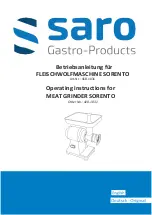
Page of 11
8
To reduce the risk of injury and to ensure maximum control during use, hold the tool with both hands
while the tool is in operation.
OPERATION:
Operating the on/off switch
1. To turn the Angle Grinder on, slide the on/off switch forward to the on position”1” (
Fig.X
)
2. To turn the Angle Grinder off, slide the on/off switch towards the rear of the Angle Grinder to
the off position “0”.
Fig G
Safe use and operation of the Angle Grinder
1. Do not expose the tool to rain or snow. Do not use the tool in damp locations or in an
environment with explosive or corrosive gas.
2. Keep your work area well lit.
3. Make sure you are well balanced when using the tool and you have secure footing. Do not
use the tool when you are tired.
4. Keep long hair away from the Angle Grinder.
5. Always inspect the Angle Grinder before use.
6. Make sure the disc is not contacting the work piece when the switch is turned on.
7. Keep the guard in place.
8.
Adjust the position of the guard to best shield the user from sparks according to the
application.
Fig H&I
9. Use only discs having a maximum operating speed at least as high as “No Load Speed”
marked on the nameplate.
10. Check the disc carefully for cracks or damage before operation. Replace cracked or
damaged discs immediately.
11. Be careful not to damage the spindle or either of the disc flanges. Damage to these parts
could result in disc breakage.
12. Hold the tool firmly.
13. Before using the tool on an actual work piece, let it run for a while. Watch for vibration or
wobbling that could indicate poor installation of the disc or a poorly balanced disc.
14. Use only discs designed for each specified function and purpose. Do not use cutting discs
for grinding or metal wheels on masonry.
15. Watch out for flying sparks. Hold the tool at an angle of approximately 15
°
-30
°
to the work
piece surface.
Fig J
16. To prevent a new grinding disc from digging in to the work piece, initial grinding should be
conducted by drawing the Angle Grinder towards yourself. Once the leading edge of the disc
is worn a little, it’s possible to grind in any direction.
17. It should never be necessary to force the tool. If the rotational speed drops abnormally,
pressure should be released immediately. Little more than the weight of the tool should be
applied. Forcing and excessive pressure can cause dangerous disc breakage or damage to
the tool.
MAINTENANCE
•
Maintain your Angle Grinder.
It is recommended that the general condition of any Angle
Grinder be examined before it is used. Keep your Angle Grinder in good repair by adopting a





























